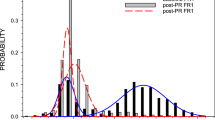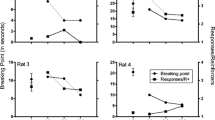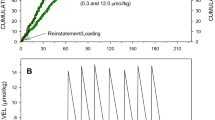Abstract
The effect of repeated administration of desipramine (DMI) on the acquisition, performance, and extinction of a lever press response for food reward was studied. Chronic administration of DMI caused a reduction in pressing under a CRF schedule both in naive and well-trained rats. Responding during extinction sessions did not differ between saline-treated rats and rats given DMI chronically. In addition, chronic administration of DMI reduced the body weight and food intake of rats on either a free-feeding or a restricted-feeding schedule. Consequently, lever pressing was also studied in a group of rats whose body weight was regulated to match the body weight of rats were administered DMI chronically. In comparison to this control group, rats administered DMI chronically responded significantly less during both reinforcement and extinction sessions. These results fail to replicate earlier reports that chronic DMI administration produces increased resistance to extinction. The results also show that assessment of food-motivated performance in rats treated chronically with DMI is difficult because of long-term changes in body weight and food intake.
Similar content being viewed by others
References
Banerjee SP, Kung LS, Riggi SJ, Chanda S (1977) Development of beta-adrenergic receptor subsensitivity by antidepressants. Nature 268: 455–456
Bylund DH, Snyder SH (1976) Beta-adrenergic receptor binding in membrane preparations from mammalian brain. Mol Pharmacol 12: 568–580
Charney DS, Menkes DB, Heninger GR (1981) Receptor sensitivity and the mechanism of action of antidepressant treatment. Arch Gen Pschiatr 38: 1160–1180
Egan J, Earley CJ, Leonard BE (1979) The effect of amitriptyline and mianserine (Org. GB94) on food motivated behaviour of rats trained in a runway: Possible correlation with biogenic amine concentration in the limbic system. Psychopharmacology 61: 143–147
Frazer A (1981) Antidepressants: Effect on adrenergic responsiveness and monoamine receptors. In: Usdin E, Bunney WE, Davis JM (eds) Neuroreceptors: Basic and clinical aspects. Wiley, New York, pp 85–98
Heydorn WE, Brunswick DJ, Frazer A (1982) Effect of treatment of rats with antidepressants on melatonin concentrations in the pineal gland and serum. J Pharmacol Exp Ther 222: 534–543
Levitsky DA, Strupp BJ, Lupoli J (1981) Tolerance to anorectic drugs: Pharmacological or artifactual. Pharmac Biochem Behav 14: 661–667
Lowry OH, Rosebrough NJ, Farr AL, Randall RJ (1951) Protein measurement with the Folin phenol reagent. J Biol Chem 193: 265–275
Maggi A, U'Prichard DC, Enna SJ (1980) Differential effects of antidepressant treatment on brain monoaminergic receptors. Eur J Pharmacol 61: 91–98
Mason ST (1979) Noradrenaline: Reward or extinction? Neurosci Biobehav Rev 3: 1–10
Mason ST, Fibiger HC (1979) The dorsal bundle extinction effect: Dependence on subtle changes in acquisition. Brain Res 166: 341–348
Mason ST, Iversen SD (1979) Theories of the dorsal bundle extinction effect. Brain Res Rev 1: 107–137
Olpe HR, Schellenberg A (1980) Reduced sensitivity of neurons to noradrenaline after chronic treatment with antidepressant drugs. Eur J Pharmacol 63: 7–13
Sarai K, Frazer A, Brunswick D, Mendels J (1978) Desmethylimipramine-induced decrease in beta-adrenergic receptor binding in rat cerebral cortex. Biochem Pharmacol 27: 2179–2181
Schultz JE, Siggins GR, Schocker FW, Turck M, Bloom FE (1981) Effects of prolonged treatment with lithium and tricyclic antidepressants on discharge frequency, norepinephrine responses and beta receptor binding in rat cerebellum: Electrophysiological and biochemical comparison. J Pharmacol Exp Ther 216: 28–38
Sellinger-Barnette MM, Mendels J, Frazer A (1980) The effect of psychoactive drugs on beta-adrenergic receptor binding sites in rat brain. Neuropharmacology 19: 447–454
Sugrue MF (1983) Chronic antidepressant therapy and associated changes in central monoaminergic receptor functioning. Pharmacol Ther 21: 1–33
Sulser F, Vetulani J, Mobley PL (1978) Mode of action of antidepressant drugs. Biochem Pharmacol 27: 257–261
Vetulani J, Stawarz RJ, Sulser F (1976) Adaptive mechanisms of the noradrenergic cyclic AMP generating system in the limbic forebrain of the rat: Adaptation to persistent changes in the availability of norepinephrine (NE). J Neurochem 27: 661–666
Willner P, Montgomery T (1981) Behavioral changes during with-drawal from desmethylimipramine (DMI). I. Interactions with amphetamine. Psychopharmacology 75: 54–59
Willner P, Montgomery T, Bird D (1981) Behavioural changes during withdrawal drom desmethylimipramine (DMI). II. Increased resistance to extinction. Psychopharmacology 75: 60–64
Willner P, Towell A (1982) Evidence suggesting that DMI-induced resistance to extinction is not mediated by the dorsal noradrenergic bundle. Brain Res 238: 251–253
Author information
Authors and Affiliations
Rights and permissions
About this article
Cite this article
Lucki, I., Frazer, A. Performance and extinction of lever press behavior following chronic administration of desipramine to rats. Psychopharmacology 85, 253–259 (1985). https://doi.org/10.1007/BF00428183
Received:
Accepted:
Issue Date:
DOI: https://doi.org/10.1007/BF00428183




